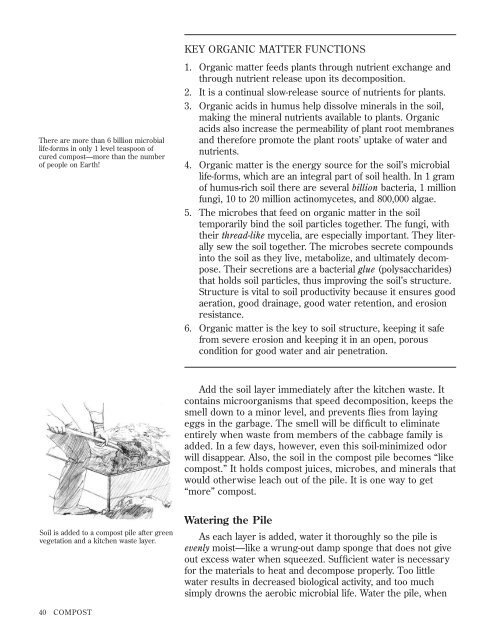How to Grow More Vegetables : And Fruits, Nuts ... - Shroomery
How to Grow More Vegetables : And Fruits, Nuts ... - Shroomery
How to Grow More Vegetables : And Fruits, Nuts ... - Shroomery
Create successful ePaper yourself
Turn your PDF publications into a flip-book with our unique Google optimized e-Paper software.
There are more than 6 billion microbial<br />
life-forms in only 1 level teaspoon of<br />
cured compost—more than the number<br />
of people on Earth!<br />
Soil is added <strong>to</strong> a compost pile after green<br />
vegetation and a kitchen waste layer.<br />
40 COMPOST<br />
KEY ORGANIC MATTER FUNCTIONS<br />
1. Organic matter feeds plants through nutrient exchange and<br />
through nutrient release upon its decomposition.<br />
2. It is a continual slow-release source of nutrients for plants.<br />
3. Organic acids in humus help dissolve minerals in the soil,<br />
making the mineral nutrients available <strong>to</strong> plants. Organic<br />
acids also increase the permeability of plant root membranes<br />
and therefore promote the plant roots’ uptake of water and<br />
nutrients.<br />
4. Organic matter is the energy source for the soil’s microbial<br />
life-forms, which are an integral part of soil health. In 1 gram<br />
of humus-rich soil there are several billion bacteria, 1 million<br />
fungi, 10 <strong>to</strong> 20 million actinomycetes, and 800,000 algae.<br />
5. The microbes that feed on organic matter in the soil<br />
temporarily bind the soil particles <strong>to</strong>gether. The fungi, with<br />
their thread-like mycelia, are especially important. They literally<br />
sew the soil <strong>to</strong>gether. The microbes secrete compounds<br />
in<strong>to</strong> the soil as they live, metabolize, and ultimately decompose.<br />
Their secretions are a bacterial glue (polysaccharides)<br />
that holds soil particles, thus improving the soil’s structure.<br />
Structure is vital <strong>to</strong> soil productivity because it ensures good<br />
aeration, good drainage, good water retention, and erosion<br />
resistance.<br />
6. Organic matter is the key <strong>to</strong> soil structure, keeping it safe<br />
from severe erosion and keeping it in an open, porous<br />
condition for good water and air penetration.<br />
Add the soil layer immediately after the kitchen waste. It<br />
contains microorganisms that speed decomposition, keeps the<br />
smell down <strong>to</strong> a minor level, and prevents flies from laying<br />
eggs in the garbage. The smell will be difficult <strong>to</strong> eliminate<br />
entirely when waste from members of the cabbage family is<br />
added. In a few days, however, even this soil-minimized odor<br />
will disappear. Also, the soil in the compost pile becomes “like<br />
compost.” It holds compost juices, microbes, and minerals that<br />
would otherwise leach out of the pile. It is one way <strong>to</strong> get<br />
“more” compost.<br />
Watering the Pile<br />
As each layer is added, water it thoroughly so the pile is<br />
evenly moist—like a wrung-out damp sponge that does not give<br />
out excess water when squeezed. Sufficient water is necessary<br />
for the materials <strong>to</strong> heat and decompose properly. Too little<br />
water results in decreased biological activity, and <strong>to</strong>o much<br />
simply drowns the aerobic microbial life. Water the pile, when












